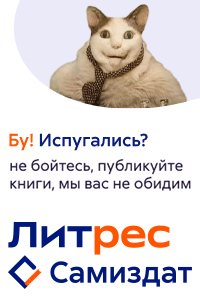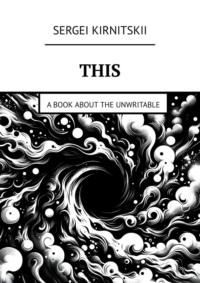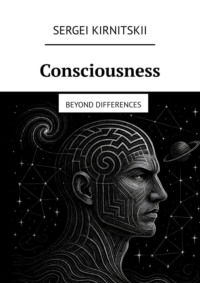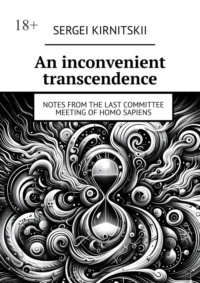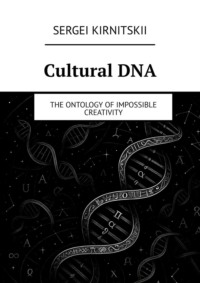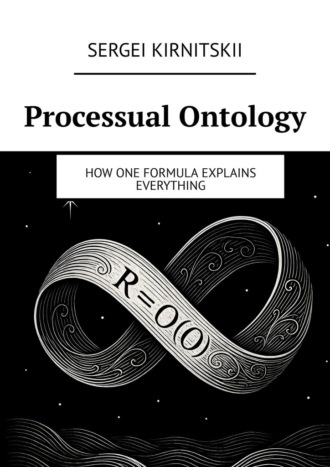
Полная версия
Processual ontology. How one formula explains everything
Attempting to remove observation. Without observation there is no distinction. Without distinction it is impossible to differentiate the existing from the non-existing, something from nothing, one from another. Reality collapses into absolute indeterminacy, which is ontologically equivalent to non-being. Observation is irreducible.
Attempting to remove self-reference. A process without self-reference requires external grounding. But where does this ground come from? It either exists (then its existence needs explaining) or does not exist (then it cannot be a ground). An infinite regress or arbitrary stopping point results. Self-reference is the only way to avoid this.
Attempting to remove processuality. Static self-relation is empty tautology: A = A. From it, multiplicity, change, development cannot be derived. Static self-reference generates nothing new. Only process through temporal unfolding creates productive self-reference.
Therefore, the formula R = O (O) represents the absolute minimum of elements necessary for a non-contradictory description of reality. Less means nothing.
Let us compare ontological economy in detail. Materialism begins with matter. But what is matter? An aggregate of particles? But particles are defined through properties. Properties manifest in interactions. Interactions presuppose space and time. Space and time require metrics. Metrics are based on distinctions. Distinctions are a form of observation. Materialism implicitly presupposes observation while denying its fundamentality.
Moreover, materialism cannot explain laws of nature. Why precisely these laws and not others? Why do laws exist at all? Why does matter obey them? Each law – an additional irreducible element of ontology. The standard model of physics contains dozens of arbitrary constants. This is not an economical ontology.
Idealism begins with ideas or consciousness. But ideas must exist somewhere. A bearer is needed – absolute consciousness, world spirit, transcendental ego. This bearer must have structure, principles of organization, dynamics of development. Each of these elements requires grounding. A no less complex system of postulates emerges.
Idealism also faces the problem of multiplicity. If everything is idea, why are there many ideas? What determines their difference? How does plurality of individual consciousnesses arise from unified consciousness? A principle of individuation is required, which becomes an additional element of ontology.
Dualism honestly acknowledges the irreducibility of the material and mental. But the price of this honesty is doubling ontological problems. Two substances need explaining instead of one. Plus the mechanism of interaction, which cannot belong to either substance (otherwise one would be reducible to the other). At least three irreducible elements result.
Panpsychism attempts to solve the problem of consciousness by attributing it to everything. But this means every elementary particle has primitive consciousness. Billions of billions of proto-consciousnesses that somehow combine into unified human consciousness. The combination problem is no less complex than the emergence problem. Plus all the complexity of the physical world remains.
Emergentism asserts consciousness arising from complex organization of matter. But this is not a solution but a statement of fact. How exactly does quantitative complexification generate the qualitatively new? What makes a certain level of complexity the threshold of consciousness? Without answers to these questions, emergentism remains description, not explanation.
Neutral monism postulates a third substance, neutral between the material and mental. But this merely pushes the problem back. Now the nature of this neutral substance and the mechanism of its differentiation into material and mental need explaining. The result is not simplification but complication.
Processual ontology postulates nothing beyond the process of self-observation. Matter is stable patterns of this process at the basic level of organization. Consciousness is the same process at the reflexive level. Laws of nature are invariant structures of the process. Space and time are forms of the process’s unfolding.
All traditional elements of ontology are derived from a single principle. This is not reductionism, since higher levels of organization possess properties irreducible to lower ones. But neither is it pluralism, since all levels are forms of a single process. This is ontological minimalism: minimum initial principles with maximum explanatory power.
Important: minimalism does not mean simplicity of result. From a simple principle, infinitely complex structure can unfold. A fractal is generated by a simple formula yet has infinite detail. So too reality: the simple principle of self-observation generates all observed complexity of the world.
The advantage of minimalism is not merely economy of thought. Minimal ontology has minimum arbitrary elements. Each postulate is an admission of the limit of explanation. The fewer postulates, the further these limits are pushed back.
Critical test: internal consistency. Materialism describes itself in terms of ideas (theories, models, laws). Idealism uses spatial-temporal metaphors (unfolding, movement of spirit). Each ontology secretly borrows from its opposite.
Конец ознакомительного фрагмента.
Текст предоставлен ООО «Литрес».
Прочитайте эту книгу целиком, купив полную легальную версию на Литрес.
Безопасно оплатить книгу можно банковской картой Visa, MasterCard, Maestro, со счета мобильного телефона, с платежного терминала, в салоне МТС или Связной, через PayPal, WebMoney, Яндекс.Деньги, QIWI Кошелек, бонусными картами или другим удобным Вам способом.


